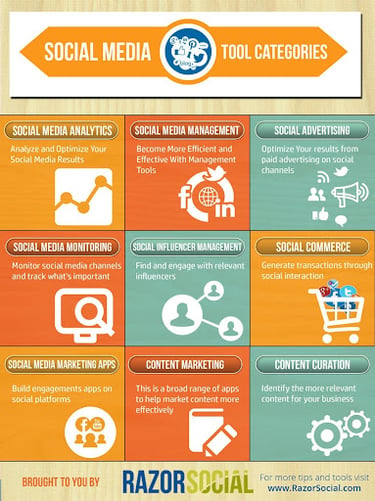Have you started social selling but aren't seeing results? Maybe you're making one of these 8 social selling mistakes.
Social selling offers opportunities for everyone from individual sales reps and contributors to C-Suite executives. Creating an authentic presence on LinkedIn and other social media channels helps you connect with more potential partners and buyers.
In fact, almost half of all businesses use social selling to expand their message to new buyers.
But despite social selling’s popularity, many brands aren’t getting a great ROI for their social selling efforts. In this article, I’ll walk you through eight reasons your social selling efforts fail and how to avoid those mistakes.
Top 8 social selling mistakes
- Your sales team hasn't been trained in social selling
- Your social sellers aren't focused on building relationships
- You don't have a social media content calendar
- You create content without understanding customer pain points
- You don’t track the results of your social selling efforts
- You use the wrong social media tools
- Your social media profiles are not optimized
- You’re not consistent with your social selling efforts
1. Your sales team hasn't been trained in social selling
Training your sales personnel is crucial for driving traffic to your social content, increasing engagement, and building deeper connections. In fact, the best sales training is likely to improve sales reps’ performance by 20%.
Suppose your sales personnel are not trained adequately in social selling. In that case, they won’t be able to engage new and existing prospects properly, discuss their needs, and offer the right solutions.
Sales reps that are equipped with good training will also be confident in their sales tactics and product features and providing the results needed to acquire and retain loyal customers.
Simply put, the better your sales personnel are trained, the more effective your social selling efforts are going to be.
How to train your sales team on effective social selling
Here are a few tips to give your sales reps a better shot at social selling success:
- Make sure your sales team understands social media and is willing to cultivate an individual presence on these platforms. After all, why would a customer trust a rep who doesn’t have an active social media profile?
- Introduce reps to different social media tools so they know when and how to use specific software to connect with customers at all levels of the buying journey.
- Communicate goals effectively to each sales rep to keep everyone aligned and accountable.
- Provide the salespeople with relevant and educational content to share on social media. This streamlines the process of social selling and encourages reps to offer valuable information to the customers.
2. Your social sellers are not building relationships
When it comes to social selling, building relationships is always going to be more effective than cold selling. Buyers don’t want to feel like they’re being sold a product at all times.
Even if you feel your product is the best, have a strong pitch, or are skilled at countering sales objections, your sales reps need to create a relationship with the customer before making a sale. Sales reps must provide value to prospects before they are going to trust what's being said.
Not doing so can make the customers feel they have fallen prey to the sales rep's tactics.
How to build relationships while social selling
Anyone can generate a one-time sale but if you don't foster real relationships with your prospects, it’ll be hard to develop lasting customer relationships.
- Get personal when chatting (but not too personal): Nobody likes a generic introduction or a copy-pasted reply that screams, 'I didn't care to read your message.' You must read the customer's query carefully and communicate with them in such a way that makes them feel important.
- Show prospects the real people behind the brand: People use social media to connect with each other. Instead of presenting yourself as a business just looking for another sale, show social media prospects you're empathetic human beings. Use personal stories of your staff and share posts that relate to your customer experience.
Above all, be genuine, be relatable, set the right price, and take time to understand who your customers are and what they might need from you.
3. You don’t have a social media content calendar
Every social selling expert should follow a content schedule to ensure they consistently post the right content.
A content calendar helps social sellers:
- Determine content priorities,
- Identify which types of content to post
- Post content at the right times
Without a content calendar, you won’t be able to focus on your long-term goals and understand what’s working and what’s not.
Additionally, randomly picked topics that don't resonate with your brand or audience can adversely impact your engagement.
How to set up a social selling content calendar
Creating a social media calendar is not an uphill task if you follow these tips:
- Choose your social channels in advance. Social channels have different features: just because your content went viral on Instagram doesn't mean it will get the same engagement on Twitter.
- Organize your content calendar using spreadsheets, Google Calendar, or use a social media management tool, like CoSchedule, Trello, or HubSpot.

- Include different types of interactive content, such as carousels, GIFs, videos, and reels.
- Think about how often you want to post to each channel, the best time to post, and so on.
Once you gather all the information, start crafting your posts. Invite your team members to provide feedback and make changes if required.
4. You create content without understanding customer pain points
Customer pain points are problems your customers experience in the marketplace along their buying journey.
Not being aware of these pain points can make social selling difficult as you create posts and content that shows you are trustworthy and authoritative in your space.
How to keep customer pain points top-of-mind when social selling
Sales and marketing teams need to work together to discover and understand the prospects’ pain points. This will enable them to present the product or service in an appealing way.
However, understanding customer pain points isn’t as easy as it seems. Here’s how you can do it:
First, group customers’ pain points into four broad categories:
- Process pain points: These are related to business systems and processes, such as inconvenience in using your product and issues with the buying process.
- Financial pain points: These are related to money, such as expensive products or services and low marketing budget.
- Support pain points: When your customers aren’t receiving help during the buying process, such as delayed response times or not being available on the customer’s preferred channel.
- Productivity pain points: When customers want a streamlined omnichannel experience when dealing with your business. For example, wasting too much time on the current solution provider or a product’s onboarding process is too high-effort.
Some other ways to better understand customer pain points include:
- Conducting qualitative market research to discover what your customers want.
- Talking to your customers and listen to their demands and issues.
- Gaining valuable insights into your customer perception by iterating with your sales and customer support teams.
5. You don’t track the results of your social selling efforts
Trying new things is good. But learning from tried and tested methods is a great way to maximize ROI with social selling.
Without tracking metrics, you won’t be able to figure out what’s working in your social selling strategy and what’s not.
It’ll be challenging to measure how your social selling strategy is performing, how successful your social campaign is, and ultimately if you will have an impact on your overall business.
How to start tracking social selling metrics
- Determine your social goals. What are you trying to achieve from your social media efforts? Do you want to spread awareness of the new product? Drive more traffic to your page? Or increase conversions?
- Gather insights and data from current and past efforts to adjust your future campaigns and messages accordingly.
- Use social platforms' analytics to create social media performance reports to share with your team.
- Focus on social media monitoring to determine what is being said about your business on different media platforms. For example, you can track such posts and take your time to respond and avoid a viral crisis.
6. You use the wrong social media tools
While the right tool can improve and streamline your social selling efforts, the wrong ones can make things worse for your business — such as more wastage of time and efforts, inaccurate insights, difficulty to use, and so on.
This leads to inconsistency in posting and interacting with your followers, resulting in unhappy followers and loss of potential sales.
How to start using the right social media tools for social selling
When it comes to picking a social media tool for your business, there are so many options out there. However, before you choose a tool, answer the following questions:
- What are your social selling goals?
- What social platform do you want to build your following on?
- Do you want to schedule your posts in advance?
- Do you want to integrate the tool with other software or apps?
Choosing constantly adapting tools will give you a better chance to stay up-to-date with the latest social media trends without having to change or add tools at an additional cost.
7. Your social media profiles are not optimized
Your personal social media profile is the place where prospects can find more information about your business, products, and services.
A fully updated profile makes a good impression on the customers and makes you look more approachable and professional.
How to optimize your social media profile for social selling
Not optimizing your profile means customers leave your social media profile without getting the information they need. Profiles that haven’t been optimized fail to drive traffic, increase email subscribers, and boost sales.
Creating an engaging, informative social media profile is crucial to converting your visitors into paying customers. The best part? It’s easy and doesn’t take much time.
Here’s how you can do it:
- Use a high-quality profile picture: Whether that’s a logo or a real person in your company, make sure it represents your brand so that prospects can identify your business quickly. Plus, use the same image across all platforms to ensure easy search.
- Update your bio: New visitors check out your profile in search of information about your brand — which is difficult to figure out with an unoptimized bio section. Be clear about what your business does, add relevant keywords, and make it unique to grab more eyeballs. Also, add a link to your website to lead them directly to it.
- Update your profile name: Your profile name is your social media identity that will distinguish you from the rest. Customers don’t like to deal with businesses that have vague names. So, make sure the social media name is consistent with your brand, company, or website.
Above all, make sure you update your profile frequently and make it look clear and crisp to get more exposure online and create an everlasting impression on your customers.
8. You’re not consistent with your social selling efforts
Even with beautiful graphics, helpful content, and advanced metrics, building and maintaining a valuable relationship with your customers takes time. Sure, these can help you know what’s working and what’s not. But, consistency is crucial when it comes to expert social selling.
Posting consistently on social media strengthens your brand and helps you build loyal followers who will share and talk about your business]. If you go weeks between posts, it’s likely your posts will not be memorable and you’ll fail to make an impact.
How to be consistent when social selling
- Set realistic goals: Avoid getting too excited and setting unrealistic goals. If posting ten times a week is too much for you, research, test and see what works for your followers. Four consistent posts every week is better than ten in a row and then nothing for weeks.
- Use tools: Social media is huge. You cannot manage it all on your own, especially if you have limited time to focus on it daily. Numerous social media tools and chatbots are available to help you maximize your time for other crucial tasks.
- Don’t overwhelm your audience with posts: This can make them unfollow or block you. Instead, post several times a week, depending on the platform and your followers. It will take a bit of trial and error. But, once you determine your schedule, stick with it.
Avoid these 8 mistakes to improve your social selling efforts
Adopting social selling techniques takes time and patience. If you’re not guided and careful, you can make tons of costly mistakes, such as not providing proper training to sales reps, being inconsistent, not keeping your social profiles updated, selling before building relationships, and so on.
We hope the above tips help you succeed in social selling. Keep these in mind and you’ll be on the right track to grow your business in no time.





